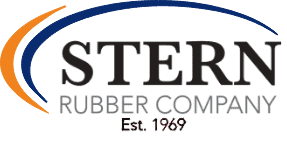Neoprene or polychloroprene is a synthetic rubber that is flexible at different temperatures, has good oil-resistance and has substantial chemical stability. Stern Rubber Company compounds our polychloroprene in house and does dense rubber molding and rubber extrusion. Neoprene offers good resistance to gasoline, oil, acids and alkalis. Its characteristics make it an excellent application for use in outdoor applications, since it has resistance to UV light, oxidation and ozone. Stern Rubber Company compounds neoprene in a dense rubber form that would be an excellent product that has properties that fall between EPDM and Nitrile. It has a temperature range between -60⁰F to 250⁰F, with a wide variety of applications depending on durometer. Some chemicals can degrade neoprene such as acetone, hydrochloric acid, chlorine and even human urine, which is why you don’t pee in your wetsuit.
DuPont scientists invented neoprene in 1930, but the rights to the patent came from Father Julius Nieuwland, who was a chemistry professor at the University of Notre Dame and was studying acetylene. Nieuwland studied the effects of acetylene could be polymerized to create a jelly like substance called divinylacetylene, which when hardens, forms an elastic compound that was similar to rubber.
The first commercial work done on this new synthetic rubber was done by DuPont’s Wallace Carothers after DuPont purchased the patent rights from the university and also including collaboration from Father Nieuwland. Later DuPont spun off a product of monovinylacetylene and they created chloroprene.
In 1931, DuPont marketed this new compound as a trademarked name DuPrene and started selling this synthetic rubber material to manufacturers of finished end products. In 1937, DuPont changed the name of DuPrene to Neoprene and DuPont is the only producer of the Neoprene brand, polychloroprene in North America.
To create sponge rubber, Stern Rubber uses a blowing agent in our dense rubber formula, so that we can create an open or closed cell foam sponge rubber; using a nitrogen blow agent gives you closed cell and a carbon dioxide agents give you open cell. While in the open-cell, neoprene is more breathable, applications for open cell neoprene include cushioning, sound damping, shock absorption and vibration control. Die cut gaskets are easily cut in neoprene sheet. A closed-cell foam neoprene is less compressible and has good waterproof tendencies.
At Stern Rubber Company, some of the products that we use neoprene or polychloroprene rubber for include motor mounts, CV boots, engine bellows, tie rod boots, grommets, seals and gaskets. Neoprene works well with compression, transfer, injection and rubber to metal bonding and also hoses that can be extruded. Since neoprene works well with electrical application, we mold electrical jackets and onto cables. Although we do not produce wetsuits at our plant, it is the number one use for neoprene.
